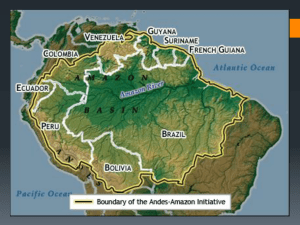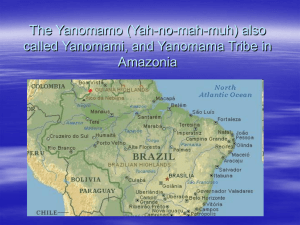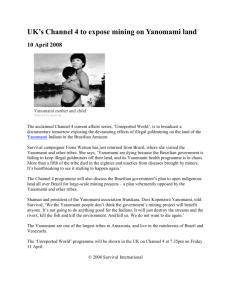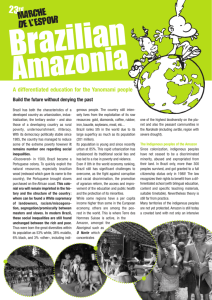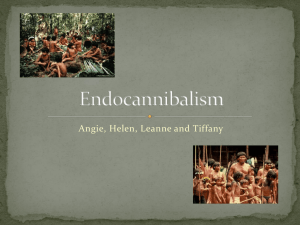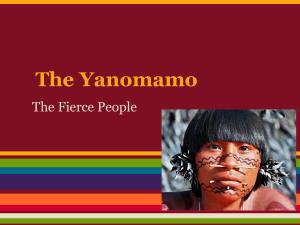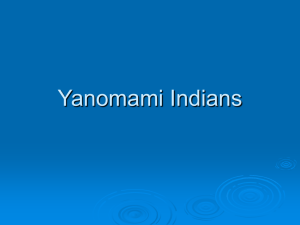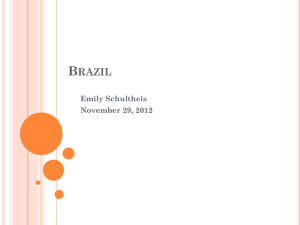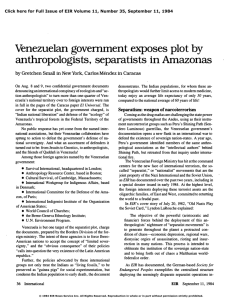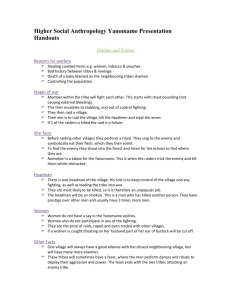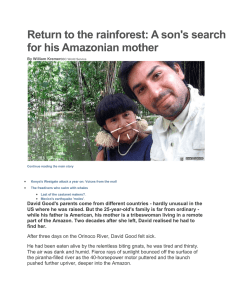Yanomami Indians: The Fierce People?
advertisement
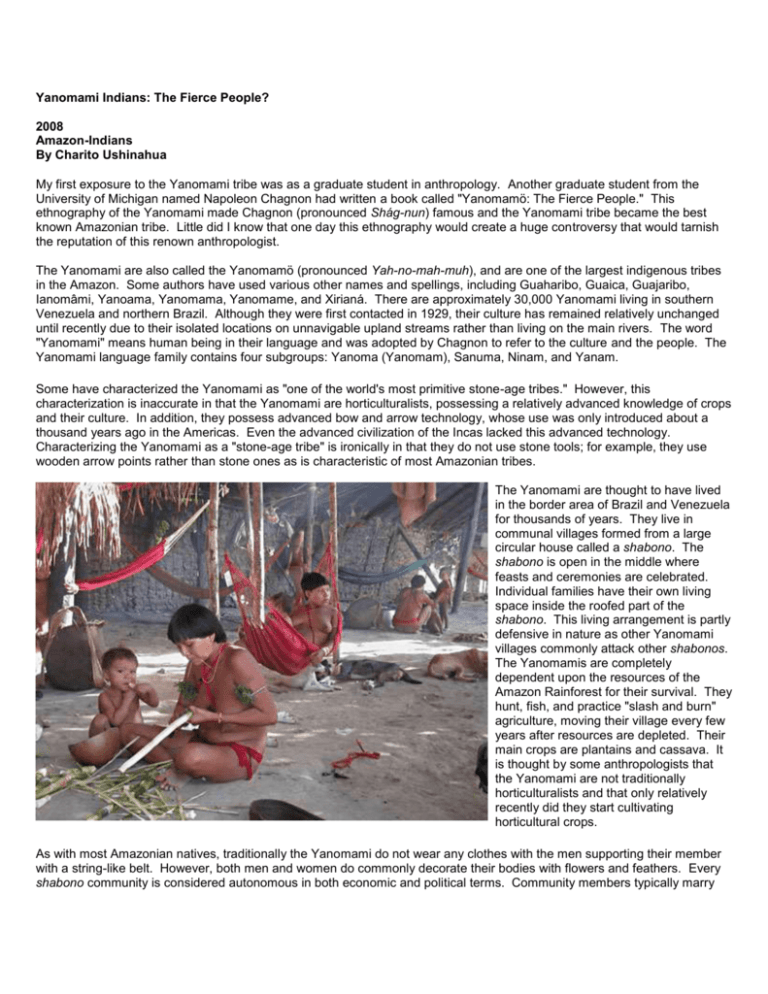
Yanomami Indians: The Fierce People? 2008 Amazon-Indians By Charito Ushinahua My first exposure to the Yanomami tribe was as a graduate student in anthropology. Another graduate student from the University of Michigan named Napoleon Chagnon had written a book called "Yanomamö: The Fierce People." This ethnography of the Yanomami made Chagnon (pronounced Shág-nun) famous and the Yanomami tribe became the best known Amazonian tribe. Little did I know that one day this ethnography would create a huge controversy that would tarnish the reputation of this renown anthropologist. The Yanomami are also called the Yanomamö (pronounced Yah-no-mah-muh), and are one of the largest indigenous tribes in the Amazon. Some authors have used various other names and spellings, including Guaharibo, Guaica, Guajaribo, Ianomâmi, Yanoama, Yanomama, Yanomame, and Xirianá. There are approximately 30,000 Yanomami living in southern Venezuela and northern Brazil. Although they were first contacted in 1929, their culture has remained relatively unchanged until recently due to their isolated locations on unnavigable upland streams rather than living on the main rivers. The word "Yanomami" means human being in their language and was adopted by Chagnon to refer to the culture and the people. The Yanomami language family contains four subgroups: Yanoma (Yanomam), Sanuma, Ninam, and Yanam. Some have characterized the Yanomami as "one of the world's most primitive stone-age tribes." However, this characterization is inaccurate in that the Yanomami are horticulturalists, possessing a relatively advanced knowledge of crops and their culture. In addition, they possess advanced bow and arrow technology, whose use was only introduced about a thousand years ago in the Americas. Even the advanced civilization of the Incas lacked this advanced technology. Characterizing the Yanomami as a "stone-age tribe" is ironically in that they do not use stone tools; for example, they use wooden arrow points rather than stone ones as is characteristic of most Amazonian tribes. The Yanomami are thought to have lived in the border area of Brazil and Venezuela for thousands of years. They live in communal villages formed from a large circular house called a shabono. The shabono is open in the middle where feasts and ceremonies are celebrated. Individual families have their own living space inside the roofed part of the shabono. This living arrangement is partly defensive in nature as other Yanomami villages commonly attack other shabonos. The Yanomamis are completely dependent upon the resources of the Amazon Rainforest for their survival. They hunt, fish, and practice "slash and burn" agriculture, moving their village every few years after resources are depleted. Their main crops are plantains and cassava. It is thought by some anthropologists that the Yanomami are not traditionally horticulturalists and that only relatively recently did they start cultivating horticultural crops. As with most Amazonian natives, traditionally the Yanomami do not wear any clothes with the men supporting their member with a string-like belt. However, both men and women do commonly decorate their bodies with flowers and feathers. Every shabono community is considered autonomous in both economic and political terms. Community members typically marry within the community with a cross-cousin, that is with the offspring of a paternal aunt or maternal uncle. With the preference for cross-cousin marriages, Yanomami society and politics is dominated by familial relations. In addition, Yanomami society is polygnous with one man commonly having multiple wives. Reproductive success is linked to the number of wives that a man has and some anthropological studies have found a positive correlation between aggression and fecundity of males. Lawrence Keeley in his book, "War before civilization: The myth of the peaceful savage," found that an astounding 35 percent of males die in warfare. Moreover, he reports that those Yanomami males who are victorious in battle typically have more wives and children. Perhaps not surprisingly, anthropological studies that portray an entire culture as violent have been criticized and have caused much debate among anthropologists. Whether or not it is justified, the Yanomami have a violent reputation that has trickled down from anthropological studies into the popular literature and culture. Like most indigenous Amazonians, the Yanomami traditionally practice animism as their religion. In the minds of the Yanomami people who live in the rainforest, the forest is not only composed of plant and animal life, but of spiritual life as well. To the Yanomami, every single tree, vine, shrub, and flower is inhabited with animal spirits. The Yanomami refer to these shamanic spirits as xapiripë (sometimes called hekura or hekurapë). In order to see these spirits one must use a hallucinogen called yopo or ebene. Yopo is prepared from the bark of the virola tree and is commonly used by shamans and lay persons as well. Most commonly, yopo is used in the afternoon after hunting and tending gardens. Yopo and potent strains of wild tobacco (Nicotiana spp.) are taken by being blown through a tube into the nasal cavities from one person to the other. In addition, this method of taking ebene represents a transfer of energy from one person to another. From the viewpoint of the shaman, taking yopo allows him to manipulate the xapiripë spirits so that they are maintained inside his body, giving him spiritual power. That is, the power to heal friends, and conversely, the power to harm enemies. A mineralogical survey of the northern Amazon by the Brazilian government in 1975 revealed the presence of gold ore in the Roraima region of Brazil. By the early 1980's, miners in search of gold began invading the Yanomami territory in Brazil and by 1987 it had become a full-fledged gold rush. Over 30,000 prospectors entered Yanomami lands and established over a hundred clandestine mining operations. The resulting massacres and diseases brought by these invaders is estimated to have caused the death of over 2,000 Yanomami. One of the problems with gold mining is the environmental destruction it causes. In order to separate gold from rocks and soil, mercury is used. Mercury in the rivers and streams bio-accumulates and permeates the entire ecosystem. The mercury accumulates in predators and hunters (such as the Yanomami) higher up the food chain and creates a neurotoxin that causes birth defects and abnormal child development. The Yanomami have had increased child mortality rates while their birth rates have declined putting their very existence into risk. Moreover, malaria increased in the area due to the stagnant pools left by the miners that increase the mosquito populations that are vectors of the disease. Some have estimated that malaria is responsible for the deaths of about 13% of the Yanomami population every year. However, the negative influence of the miners extends beyond physical health. Their introduction of alcohol and other western goods has had an immense negative effect on Yanomami society itself. In response to the crisis created by the gold miners, in 1992 the Yanomami territory was protected by the Brazilian government by creating a federal indigenous reserve. However, the gold miners were not happy about the creation of the reserve and in July, 1993, a group of miners tried to exterminate an entire village in what has become to be known as the "Haximu Massacre." At lease 16 Yanomami were killed in what many have called genocide. Some of the miners were tried and convicted and after numerous appeals on the 7th of August, 2006 the Brazilian Supreme Federal Court reaffirmed that the crime known as the Haximu Massacre and upheld the ruling sentencing the miners to 19 years in prison for genocide. However, to this day there is political pressure by the mining industry to reduce the Yanomami territory and allow commercial mining operations on their lands. In the year 2000, a journalist named Patrick Tierney published a book called, "Darkness in El Dorado," and accused anthropologist Napoleon Chagnon and his colleague geneticist James Neel of numerous misdeeds, among them intentionally creating an epidemic of measles among the Yanomami people in order to study the effects of natural selection on primitive societies. Tierney states that the resulting epidemic caused the death of hundreds of Yanomami. Incredibly, Tierney charged that the experiments were funded by the US Atomic Energy Commission, who sought to model the societal consequences of mass mortality caused by nuclear war. In addition to the measles epidemic, Tierney charged that Chagnon mischaracterized the Yanomami as "The Fierce People" when in fact it was Chagnon who was causing the violence by introducing enormous amounts of western goods such as machetes into the Yanomami society, thus stimulating warfare over the introduced goods. Tierney also accused Chagnon of fraud by staging films, such as "The Axe Fight" that he helped produce. The journalist charged that the anthropologist prescripted the films and that they were not spontaneous as portrayed. Tierney's book caused an uproar in the anthropological community and the American Anthropological Association (AAA) got involved in the debate. In fact, the AAA convened a special commission to investigate the allegations against Chagnon and Neel. The report by the AAA issued in May, 2002 exonerated the anthropologist and geneticist from causing a measles epidemic among the Yanomami. Nonetheless, the AAA criticized some aspects of Chagnon's research, including his portrayal of the Yanomami as "The Fierce People," and his bribing of Venezuelan officials. However, the AAA debate was not over and three years later in June, 2005 they rescinded the acceptance of the 2002 report. As someone who is working to support indigenous people, I would like to point out that over the many years since publishing his first book on the Yanomami (whose revenues made him a millionaire), Chagnon has failed to bring significant aid to the Yanomami people. In fact, he sought to damage the indigenous movement by publicly criticizing Davi Kopenawa, a Yanomami activist who helped establish the Yanomami reserve in Brazil. One might ask if it was proper behavior for an anthropologist to hurt the efforts of an indigenous Amazonian activist attempting to defend his people. Interestingly, the Yanomami leader Davi Kopenawa has predicted the destruction of the entire human race if the Amazon Rainforest is destroyed. Kopenawa states, "The forest-land will only die if it is destroyed by whites. Then, the creeks will disappear, the land will crumble, the trees will dry and the stones of the mountains will shatter under the heat. The xapiripë spirits who live in the mountain ranges and play in the forest will eventually flee. Their fathers, the shamans, will not be able to summon them to protect us. The forest-land will become dry and empty. The shamans will no longer be able to deter the smoke-epidemics and the malefic beings who make us ill. And so everyone will die." Many ecologists seem to agree with Kopenawa, believing that the Amazon Rainforest are the "lungs of the Earth" and that if the Amazon is destroyed, it will cause a global ecological disaster resulting in the eventual destruction of the human race. Copyright 2008 Charito Ushinahua, Yanomami Indians
